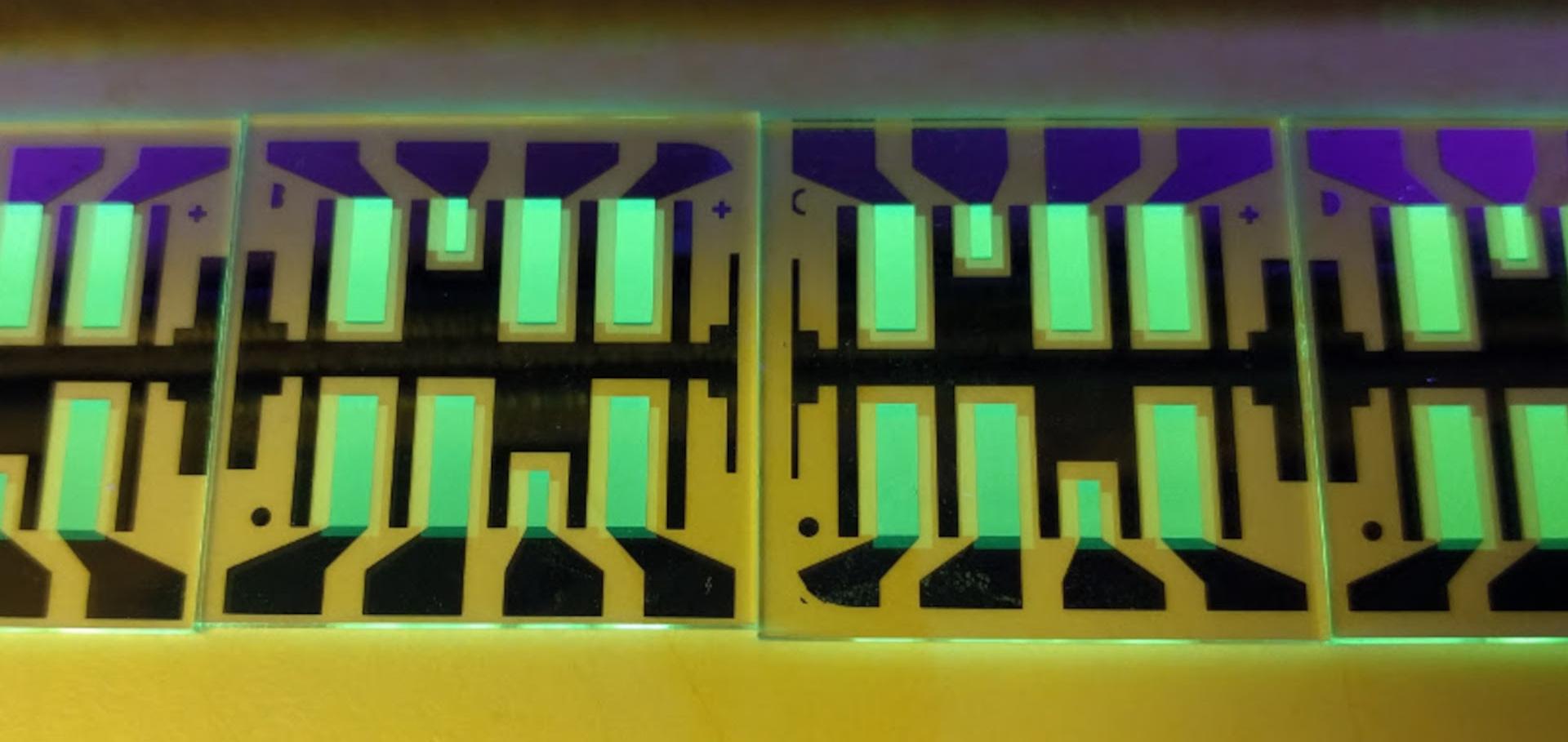Highly efficient semitransparent tandem organic solar cells with complementary absorber materials
Applied Physics Letters 99:4 (2011)
Abstract:
We present highly efficient, semitransparent small molecule organic solar cells. The devices employ an indium tin oxide-free top contact, consisting of thin metal films. An additional organic layer is used to enhance light outcoupling. The solar cell incorporates two stacked subcells, each containing a donor:acceptor bulk heterojunction. The two subcells have complementary absorbers, with separate blue (C60), red (fluorinated zinc phthalocyanine), and green (dicyanovinyl oligothiophene derivative) absorbing molecules. A power conversion efficiency of 4.9 ≤ 0.2 is obtained for the device having an average transmission of 24 in the visible range. © 2011 American Institute of Physics.Influence of hole-transport layers and donor materials on open-circuit voltage and shape of I-V curves of organic solar cells
Advanced Functional Materials 21:11 (2011) 2140-2149
Abstract:
The effect of injection and extraction barriers on flat heterojunction (FHJ) and bulk heterojunction (BHJ) organic solar cells is analyzed. The barriers are realized by a combination of p-type materials with HOMOs varying between -5.0 and -5.6 eV as hole-transport layer (HTL) and as donor in vacuum-evaporated multilayer p-i-metal small-molecule solar cells. The HTL/donor interface can be seen as a model for the influence of contacts in organic solar cells in general. Using drift-diffusion simulations we are well able to reproduce and explain the experimental I-V curves qualitatively. In FHJ solar cells the open-circuit voltage (Voc) is determined by the donor and is independent of the HTL. In BHJ solar cells, however, Voc decreases if injection barriers are present. This different behavior is caused by a blocking of the charge carriers at a spatially localized donor/acceptor heterojunction, which is only present in the FHJ solar cells. The forward current is dominated by the choice of HTL. An energy mismatch in the HOMOs leads to kinks in the I-V curves in the cases for which Voc is independent of the HTL. The influence of energy barriers (ΔE) for hole transport on the J-V curve is analyzed in experiments and simulations. The investigated system consists of different combinations of organic hole-transport layers (HTLs) and donors. Depending on the kind of barrier and the configuration of the donor/acceptor heterojunction changes in the open-circuit voltage (V oc) and the formation of S-kinks are observed and explained. Copyright © 2011 WILEY-VCH Verlag GmbH & Co. KGaA, Weinheim.Investigation of C60F36 as low-volatility p-dopant in organic optoelectronic devices
Journal of Applied Physics 109:10 (2011)
Abstract:
We demonstrate highly efficient small molecule organic light emitting diodes and organic solar cells based on the p-i-n-type structure using the fluorinated fullerene molecule C60F36 as p-dopant in the hole transport layer. We present synthesis, chemical analysis, and energy level investigation of the dopant as well as the conductivity of organic layers consisting of a matrix of N,N,N′,N′-tetrakis 4-methoxyphenyl- benzidine(MeO-TPD) or N,N′-[(Diphenyl-N,N′-bis)9, ? 9,-dimethyl-fluoren-2-yl]-benzidine(BF-DPB) doped by the fullerene compound. State of the art organic p-i-n devices containing C60F36 show efficiencies comparable to devices with the commonly used p-dopant2,3,5,6-tetrafluoro-7,7,8,8-tetracyanoquinodimethane (F4-TCNQ). The advantages of the fullerene based dopant are the low volatility and high thermal stability, which is beneficial for device operation under elevated temperature. These properties make C60F36 highly attractive for the usage as p-dopant in a broad spectrum of organic p-i-n devices like organic light emitting diodes, solar cells, memories, or transistors. © 2011 American Institute of Physics.Total charge amount as indicator for the degradation of small molecule organic solar cells
Solar Energy Materials and Solar Cells 95:5 (2011) 1278-1283
Abstract:
We show that the number of extracted charge carriers is a suitable measure to compare lifetime measurements on organic solar cells at different intensities. In detail, we used pin-structures with active layers containing a bulk heterojunction of Zincphthalocyanine (ZnPc) and C60. Extended lifetime measurements under constant monochromatic or white illumination at defined temperatures of 50 °C or 90 °C are done. On the one hand, we show that the number of extracted charge carriers is important to determine the degree of degradation. On the other hand, our results show that the energy of irradiated photons is significant for accelerated measurements. This is an major advantage for the realisation of accelerated lifetime measurements. Additionally, we find that not single charge carriers, but excitons cause the degradation of the observed solar cells. © 2010 Elsevier B.V. All rights reserved.Homoleptic Co(II), Ni(II), Cu(II), Zn(II) and Hg(II) complexes of bis-(phenyl)-diisoindol-aza-methene.
Dalton Trans 40:14 (2011) 3476-3483


